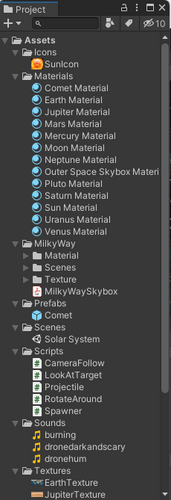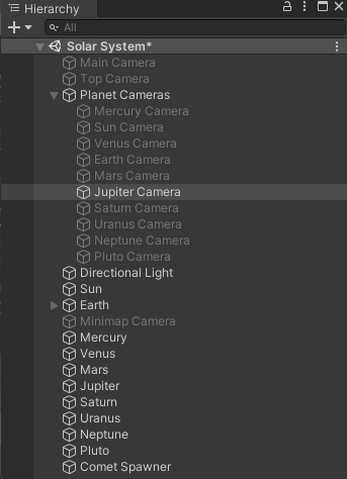"Almost-to-Scale" Solar System 2.1
This is my almost-to-scale Solar System project. Elements included:
- Sun
- Mercury
- Venus
- Earth
- Earth's Moon
- Mars
- Jupiter
- Saturn
- Uranus
- Neptune
- Pluto
- Comets
- Main Camera
- Minimap Camera
- Camera for each planet
The Challenges:
The sun is huge! The distance between each planet is huge.
Bringing the camera too close to the sun might make the planets bigger, but the sun will fill the screen and you'll only see the planets as they pass between the sun and the camera. To "sort of" help with the different views, I created a camera for each planet. You won't have access to these in this version. The Earth Camera is currently active in this version.
The planet sizes are appropriately proportioned to scale. This is how you can expect the planets to look next to each other and compared to the sun. The distance between each planet was scaled down. In order to scale appropriately distances between planets, for example, the Earth would have to be at Vector3(15675, 0, 0) or x = 15,675. As you can imagine, to see the sun and the earth in the same view is not possible in that scenario. The position of x was scaled down to 167.66 (which doesn't match to the scale of the planets and the sun).
All 9 planets exist, but may be out of view as the camera follows the Earth. You can click on other planets (such as mars) to hopefully get a view of Jupiter. The trick... trying to click on mars as it moves through the view. Good Luck!
To Scale:
- Planet Sizes are To Scale
- The Sun is To Scale
- Planet Distances are To Scale, but at a different scale than planet sizes (e.g., the planets compared to other planets and the sun are to scale and the distances between each planet are to scale, but the sizes of the planets use a different scale than the distances between each in order to fit the planets in the viewport, mostly).
- Planet Rotation Speed is To Scale.
- Planet Rotation on Axis is To Scale (degree rotation).
- Venus and Uranus rotate in a different direction than the other planets.
- The moon rotates around the earth at the same speed as Earth's rotation. This is why we always see the same side of the moon.
- Planet's orbital distances (around the Sun) and speed are to scale.
Upon request... I can upload another version of the game using a particular planet's camera. Jupiter's is the best.
| Status | Released |
| Platforms | HTML5, Windows |
| Author | d14u82 |
| Genre | Simulation |
| Made with | Unity |
| Tags | solar-system |
Download
Click download now to get access to the following files:


Leave a comment
Log in with itch.io to leave a comment.